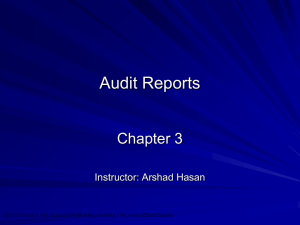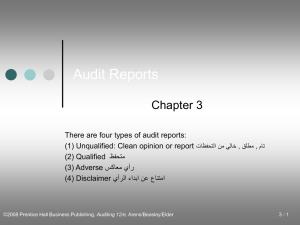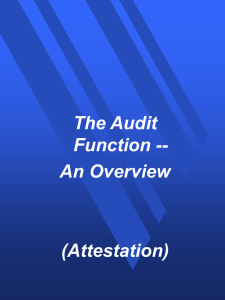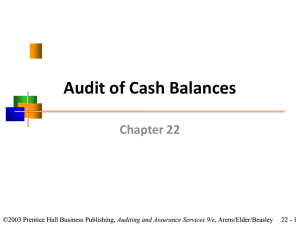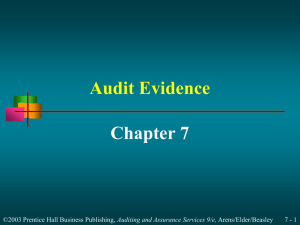Chapter 26 – Internal and Governmental Financial Auditing and
advertisement
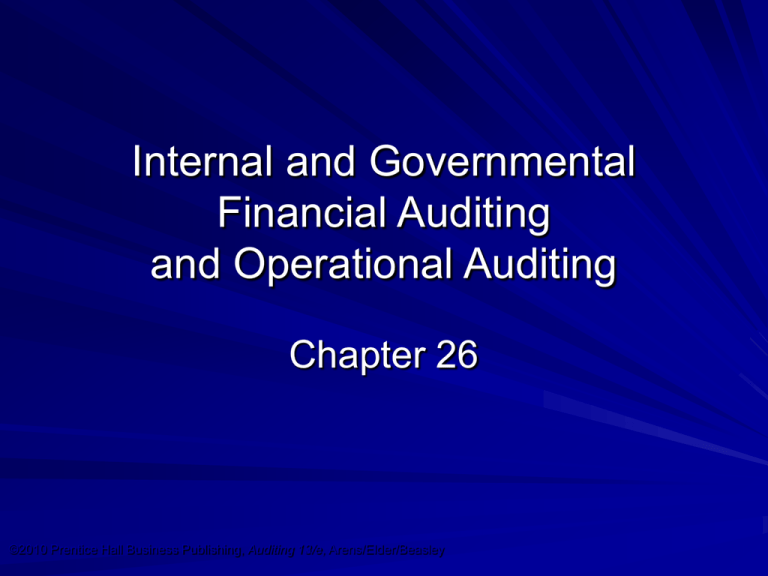
Internal and Governmental Financial Auditing and Operational Auditing Chapter 26 ©2010 Prentice Hall Business Publishing, Auditing 13/e, Arens/Elder/Beasley 26 - 1 Learning Objective 1 Explain the role of internal auditors in financial auditing. ©2010 Prentice Hall Business Publishing, Auditing 13/e, Arens/Elder/Beasley 26 - 2 Internal Auditing The New York Stock Exchange requires its registrants to have an internal audit function ©2010 Prentice Hall Business Publishing, Auditing 13/e, Arens/Elder/Beasley 26 - 3 Internal Auditing It is an independent, objective assurance and consulting activity designed to add value and improve an organization’s operations. It helps an organization accomplish its objectives by bringing a systematic, disciplined approach to evaluate and improve the effectiveness of risk management, control, and governance processes. ©2010 Prentice Hall Business Publishing, Auditing 13/e, Arens/Elder/Beasley 26 - 4 Institute of Internal Auditors Ethical Principles Objectivity Confidentiality Competency ©2010 Prentice Hall Business Publishing, Auditing 13/e, Arens/Elder/Beasley 26 - 5 Institute of Internal Auditors Rules of Conduct Integrity Objectivity Confidentiality Competency ©2010 Prentice Hall Business Publishing, Auditing 13/e, Arens/Elder/Beasley 26 - 6 Relationship of Internal and External Auditors Differences: The internal auditor is responsible to management The external auditor is responsible to financial statement users ©2010 Prentice Hall Business Publishing, Auditing 13/e, Arens/Elder/Beasley 26 - 7 Relationship of Internal and External Auditors Similarities: Competency Objectivity Methodology Audit risk model ©2010 Prentice Hall Business Publishing, Auditing 13/e, Arens/Elder/Beasley 26 - 8 Learning Objective 2 Describe the auditing and reporting requirements under Government Auditing Standards and the Single Audit Act ©2010 Prentice Hall Business Publishing, Auditing 13/e, Arens/Elder/Beasley 26 - 9 Governmental Financial Auditing The primary source of authoritative literature for performance of government audits is Government Auditing Standards, which is issued by the GAO. Because of the color of the cover, it is usually referred to as the “Yellow Book.” ©2010 Prentice Hall Business Publishing, Auditing 13/e, Arens/Elder/Beasley 26 - 10 Governmental Financial Auditing The Yellow Book standards are often called generally accepted government auditing standards (GAGAS). ©2010 Prentice Hall Business Publishing, Auditing 13/e, Arens/Elder/Beasley 26 - 11 Financial Audit and Reporting Requirements – Yellow Book Materiality and significance Compliance auditing Reporting ©2010 Prentice Hall Business Publishing, Auditing 13/e, Arens/Elder/Beasley 26 - 12 Audit and Reporting – Single Audit Act and OMB Circular A-133 The threshold for requiring a single audit is $500,000. The office of Management and Budget issued a revised Circular A-133, Audits of States, Local Governments, and Non-Profit Organizations, to provide administrative guidance for implementing the single audit requirements. ©2010 Prentice Hall Business Publishing, Auditing 13/e, Arens/Elder/Beasley 26 - 13 Audit Requirements The audit should be in accordance with generally accepted government auditing standards (GAGAS). The auditor must obtain an understanding of internal control over federal programs sufficient to support a low assessed level of control risk for major programs. ©2010 Prentice Hall Business Publishing, Auditing 13/e, Arens/Elder/Beasley 26 - 14 Audit Requirements The auditor should determine whether the client had complied with the laws, regulations, and the provisions of contracts or grant agreements that may have a direct and material effect on each of its major programs. ©2010 Prentice Hall Business Publishing, Auditing 13/e, Arens/Elder/Beasley 26 - 15 Reporting Requirements An opinion on whether the financial statements are in accordance with GAAP An opinion as to whether the schedule of federal awards is presented fairly in all material respects in relation to the financial statements as a whole ©2010 Prentice Hall Business Publishing, Auditing 13/e, Arens/Elder/Beasley 26 - 16 Reporting Requirements A report on internal control related to the financial statements and major programs A report on compliance with laws, regulations, and the provisions of contracts or grant agreements A schedule of findings and questioned costs ©2010 Prentice Hall Business Publishing, Auditing 13/e, Arens/Elder/Beasley 26 - 17 Operational Auditing The purpose of operational auditing is to determine the effectiveness or efficiency of any part of an organization ©2010 Prentice Hall Business Publishing, Auditing 13/e, Arens/Elder/Beasley 26 - 18 Learning Objective 3 Distinguish operational auditing from financial auditing. ©2010 Prentice Hall Business Publishing, Auditing 13/e, Arens/Elder/Beasley 26 - 19 Differences Between Operational and Financial Auditing Purpose of the audit Distribution of the reports Inclusion of nonfinancial areas ©2010 Prentice Hall Business Publishing, Auditing 13/e, Arens/Elder/Beasley 26 - 20 Learning Objective 4 Provide an overview of operational audits. ©2010 Prentice Hall Business Publishing, Auditing 13/e, Arens/Elder/Beasley 26 - 21 Effectiveness Versus Efficiency Effectiveness refers to the accomplishment of objectives Efficiency is defined as reducing costs without reducing effectiveness ©2010 Prentice Hall Business Publishing, Auditing 13/e, Arens/Elder/Beasley 26 - 22 Effectiveness Versus Efficiency Types of Inefficiency Example Acquisition of goods and services is too costly Bids for purchases of materials are not required Raw materials are not available when needed An assembly line was shut down for lack of materials A duplication of effort by employees exists Production and accounting keep identical records ©2010 Prentice Hall Business Publishing, Auditing 13/e, Arens/Elder/Beasley 26 - 23 Effectiveness Versus Efficiency Types of Inefficiency Example Work is done that serves no purpose Vendors’ invoices and receiving reports are filed without being used There are too many employees Office work could be done with one less assistant ©2010 Prentice Hall Business Publishing, Auditing 13/e, Arens/Elder/Beasley 26 - 24 Relationship Between Operational Auditing and Internal Controls Reliability of financial reporting Efficiency and effectiveness of operations Compliance with applicable laws and regulations ©2010 Prentice Hall Business Publishing, Auditing 13/e, Arens/Elder/Beasley 26 - 25 Types of Operational Audits Functional Organizational Special assignments ©2010 Prentice Hall Business Publishing, Auditing 13/e, Arens/Elder/Beasley 26 - 26 Who Performs Operational Audits Internal auditors Government auditors CPA firms ©2010 Prentice Hall Business Publishing, Auditing 13/e, Arens/Elder/Beasley 26 - 27 Independence and Competence of Operational Auditors The two most important qualities for an operational auditor are: Independence Competence ©2010 Prentice Hall Business Publishing, Auditing 13/e, Arens/Elder/Beasley 26 - 28 Learning Objective 5 Plan and perform an operational audit. ©2010 Prentice Hall Business Publishing, Auditing 13/e, Arens/Elder/Beasley 26 - 29 Specific Criteria Questions that might be used to evaluate plant layouts: Were all plant layouts approved by home office engineering at the time of original design? Has home office engineering done a reevaluation study of plant layout in the past five years? ©2010 Prentice Hall Business Publishing, Auditing 13/e, Arens/Elder/Beasley 26 - 30 Specific Criteria Is each piece of equipment operating at least 60 percent of capacity for three months or more each year? Does layout facilitate the movement of new materials to the production floor? Does layout facilitate the production of finished goods? ©2010 Prentice Hall Business Publishing, Auditing 13/e, Arens/Elder/Beasley 26 - 31 Specific Criteria Does layout facilitate the movement of finished goods to distribution centers? Does the plant layout effectively use existing equipment? Is the safety of employees endangered by the plant layout? ©2010 Prentice Hall Business Publishing, Auditing 13/e, Arens/Elder/Beasley 26 - 32 Sources of Criteria Historical performance Benchmarking Engineered standards Discussion and agreement ©2010 Prentice Hall Business Publishing, Auditing 13/e, Arens/Elder/Beasley 26 - 33 Phases in Operational Auditing Planning Evidence accumulation and evaluation Reporting and follow up ©2010 Prentice Hall Business Publishing, Auditing 13/e, Arens/Elder/Beasley 26 - 34 Planning Scope of engagement Staffing Background information Understand internal control Decide on appropriate evidence ©2010 Prentice Hall Business Publishing, Auditing 13/e, Arens/Elder/Beasley 26 - 35 Evidence Accumulation and Evaluation Documentation Client inquiry Analytical procedures Observation ©2010 Prentice Hall Business Publishing, Auditing 13/e, Arens/Elder/Beasley 26 - 36 Reporting and Follow Up Two major differences in operational and financial auditing reports: 1. In operational audits, the report is usually sent only to management 2. Tailoring of each report is required in operational audits ©2010 Prentice Hall Business Publishing, Auditing 13/e, Arens/Elder/Beasley 26 - 37 Examples of Operational Audit Findings Outside janitorial firm saves $160,000 Use the right tool Computer programs save manual labor ©2010 Prentice Hall Business Publishing, Auditing 13/e, Arens/Elder/Beasley 26 - 38 End of Chapter 26 ©2010 Prentice Hall Business Publishing, Auditing 13/e, Arens/Elder/Beasley 26 - 39
